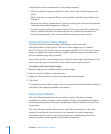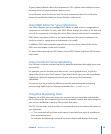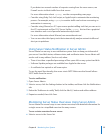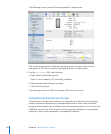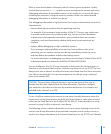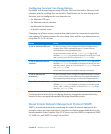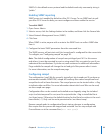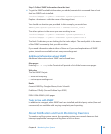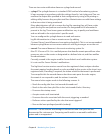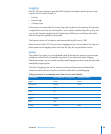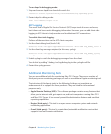
Conguring Common Core Dump Options
By default, core dumps happen using UDP port 1069 over the built-in Ethernet (en0)
interface, and the resulting les are stored in /PanicDumps on the core dump server.
However, you can congure the core dump to use:
An alternate UDP port Â
An alternate network interface Â
An alternate le destination Â
A specic network router Â
Changing any of these options requires that you restart the computers to reload the
new settings. All settings assume the core dump client and the core dump server are
using Mac OS X v10.5 or later.
Option Action
To set an alternate UDP port... On the core dump server, change the SockServiceName string
property from 1069 to the desired port in /System/Library/
LaunchDaemon/com.apple.kdump.plist.
On the core dump client, add the _panicd_port ag to the
NVRAM
boot-args. For example, to change it to UDP port 12345,
add “_panicd_port=12345” to the list of
boot-args ags.
To set an alternate network
interface...
On the core dump client, add the
kdp_match_name ag to the
NVRAM
boot-args. For example, to change it to always use en1,
add “kdp_match_name=en1” to the list of
boot-args ags after
the
_panicd_ip ag.
AirPort interfaces cannot be used to transmit core dumps.
To set an alternate le
destination...
On the core dump server, change the expected directory location
in the /System/Library/LaunchDaemons/com.apple.kdumpd.plist
le, ProgramArguments string, then reload the kdumpd process.
To specify a network router... On the core dump client, add the
_router_ip ag to the
NVRAM
boot-args. For example, to change it to use the router
10.0.0.1, add “_router_ip=10.0.0.1” to the list of
boot-args ags
after the
_panicd_ip ag.
To change the location of the core dump directory, change the expected directory
location in the com.apple.kdumpd.plist le, then reload the process.
About Simple Network Management Protocol (SNMP)
SNMP is a common protocol for monitoring the status of network equipment (for
example, routers and smart switches), computers, and other networkable devices like
Uninterruptable Power Supplies. Mac OS X Server uses Net-SNMP to implement SNMP
v1, SNMP v2c, and SNMP v3 using IPv4 and IPv6.
180 Chapter 8 Monitoring Your System



